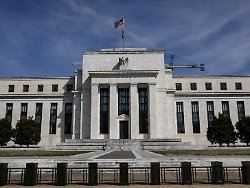Wednesday April 28, 2021
Confirmed expectations
The Fed is leaving the key interest rate close to zero
The decision was unanimous: The Federal Reserve’s central bankers are continuing their previous course. This means that neither the security purchases nor the key interest rate will be affected. Analysts do not expect this practice to be abandoned until next year.
The US Federal Reserve (Fed) is sticking to its historically loose monetary policy. As expected, the key interest rate will remain at the very low level of 0.0 to 0.25 percent. This is appropriate given the situation on the labor market and the long-term low inflation rate, said the central bank.
Securities purchases of around 120 billion US dollars a month to support the economy will also continue. Until “substantial progress” can be seen in achieving its goals, as the central bank affirmed in its communiqué. Since June 2020, the Fed has been buying government bonds for $ 80 billion and mortgage bonds for $ 40 billion a month.
The decision to leave the key interest rate at 0.0 to 0.25 percent was unanimous. Economists and stockbrokers had expected these decisions. The Fed assumes that the US economy is on the verge of a strong upswing, but that the normalization of the labor market will take some time. The market players are currently concerned primarily with one question, namely when the Fed will begin to “taper” its purchase program.
Economists expect inflation to reach three percent by the middle of the year due to temporary factors and then decline again. Primary traders polled by the New York Fed in March expected the central bank to begin reducing bond purchases in the first quarter of 2022 and stopping them by the end of next year. The first rate hike would likely come some time after that. The US central bankers assume that they will leave rates unchanged until 2023, as they themselves predict.
Labor market plagued by “pandemic dislocations”
At the same time, the Fed currently sees a recovery trend in the economy and on the labor market, which is taking place in an environment of vaccination progress and strong support from the state and the central bank. The job market, which was badly shaken by the Corona crisis, recently reported back with power – 916,000 new jobs were created in March, and experts are expecting a similarly high job increase in April. “Even if the US labor market has surprised positively in recent weeks due to the rapid progress in vaccination, it is still far from full employment due to the massive pandemic upheaval,” said economist Friedrich Heinemann from the Mannheim ZEW. There is therefore no reason for the Fed to cut back bond purchases in the short term.
But the economic engine is likely to have revved up again at the beginning of the year: For Thursday’s gross domestic product figures in the first quarter, experts surveyed by Reuters expect an annualized plus of 6.1 percent, after an increase of 4.3 percent End of 2020. “The US Federal Reserve is still keeping its hand away from the tap, which could curb the lavish inflow of liquidity for the economy and financial markets. But the discussion about tapering will become more intense in the coming weeks,” said economist Bastian Hepperle from Bankhaus Lampe .
.
